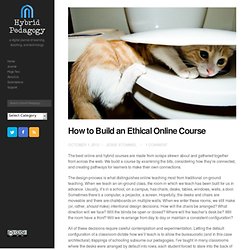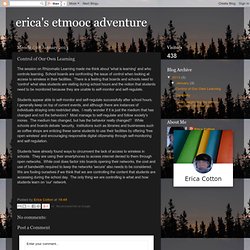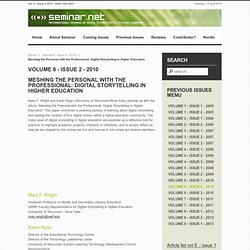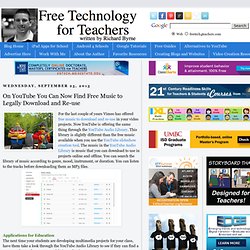

Rich On-line Discussion. 20 Tips for Creating a Professional Learning Network. How to Build an Ethical Online Course. The best online and hybrid courses are made from scraps strewn about and gathered together from across the web.

We build a course by examining the bits, considering how they’re connected, and creating pathways for learners to make their own connections. The design-process is what distinguishes online teaching most from traditional on-ground teaching. When we teach an on-ground class, the room in which we teach has been built for us in advance. Usually, it’s in a school, on a campus, has chairs, desks, tables, windows, walls, a door.
Sometimes there’s a computer, a projector, a screen. All of these decisions require careful contemplation and experimentation. When we teach online, we have to build both the course and the classroom. Hybrid classes demand an even more complex architecture, requiring consideration of the physical space(s) we’ll work within, the virtual space(s), as well as the various ways we’ll move between the spaces.
Jason Ohler : Education and Technology. Focusing on storytelling The Digital Age is the Storytelling Age... we all get to tell our stories in our own way on the great stage of the Internet...

A result of the Storytelling Age is that students come to school already immersed in the story culture through digital channels - as well as interpersonal communication at home and with friends. Control of Our Own Learning. The session on Rhizomatic Learning made me think about 'what is learning' and who controls learning.

School boards are confronting the issue of control when looking at access to wireless in their facilities. There is a feeling that boards and schools need to 'control' what sites students are visiting during school hours and the notion that students need to be monitored because they are unable to self-monitor and self-regulate. Students appear able to self-monitor and self-regulate successfully after school hours. I generally keep on top of current events, and although there are instances of individuals straying onto restricted sites, I really wonder if it is just the medium that has changed and not the behaviors? Interview with Dave Cormier: Rhizomatic Education. Two Weeks into ETMOOC; How Have I Changed? I am two weeks into my first ever MOOC - Massive (Gargantuan, Humongous, Ginormous) Open On-line Course (Community?)

And I'm looking for signs of learning. I signed up for this course, a newbie on Twitter, to learn more about digital tools. I wanted to learn about how to help my students become "connected learners". Edtech-cheatsheet.jpg 1,000×4,528 pixels. #ETMOOC Lip Dub. One of the projects the participants of #ETMOOC are completing is a collaborative "Lip Dub" of a well known song!

If you aren't familiar with this type of project, here is an example that I LOVED! I can't imagine how much work would have had to go into creating a live presentation like that! Since the participants of #ETMOOC are located all around the world, however, we will be creating a video comprised of several individual clips. Educational Hash Tags. #edude#eduFollowChallenge#edugreen #eduhashtag #eduit#edumindset#eduON (Ontario)#euduoz #edupd#edupreneur#edupunk #edutech #EduThingsILike#eduvc#eduvoxers.

Rushton's Resources. Kick Start Activity 5 – Beginner – Enhancing posts with images. Welcome to the Teacher Challenge!

This post is part of the beginners series for 30 Days to Kick Start Your Blogging. You don’t have to have ever published a “post” before, or maybe you’ve started to blog once or twice but haven’t quite yet stuck with it. Meshing the Personal with the Professional: Digital Storytelling in Higher Education. Mary F.

Wright and Karen Ryan (University of Wisconsin-River Falls) provide us with the article “Meshing the Personal with the Professional: Digital Storytelling in Higher Education” This paper chronicles a yearlong journey of learning about digital storytelling and leading the creation of five digital stories within a higher education community. The many uses of digital storytelling in higher education are explored as a reflective tool for practice, to highlight academic projects, interests or initiatives, and to simply reflect on how we are shaped by the stories we live and how we in turn share our diverse identities.
Mary F. Wright Assistant Professor of Middle and Secondary Literacy EducationUWRF Faculty Representative for Digital Storytelling in Higher EducationUniversity of Wisconsin - River Falls mary.wright@uwrf.eduThis email address is being protected from spambots. What Else - A Digital PLN Story #etmooc. How do you build a PLN?

Take a risk. Be JoLLE: Join, Lurk, Learn, Extend. In 2011 Denise Krebs and I began an adventure, and I am forever grateful for the friends and support that have been shared back and forth since then, and continues even now. Here’s our story, approved by Denise, my friend, because @cogdog asked for stories of positive connections: On YouTube You Can Now Find Free Music to Legally Download and Re-use. For the last couple of years Vimeo has offered free music to download and re-use in your video projects.

Now YouTube is offering the same thing through the YouTube Audio Library. This library is slightly different than the free music available when you use the YouTube slideshow creation tool. The music in the YouTube Audio Library is music that you can download to use in projects online and offline. You can search the library of music according to genre, mood, instrument, or duration.
You can listen to the tracks before downloading them as MP3 files. How to Create YouTube Photo Slideshows - A Good Alternative to Animoto. Animoto is an excellent tool for creating audio slideshows. But there are some limitations to it that some teachers don't like. Most notable of those limitations is the time limit (30 seconds unless you get an Animoto for Education account), lack of space for text, and that students have to remember a username and password to use it. The YouTube slideshow tool provides a tool for creating audio slideshows without those three limitations of Animoto. YouTube Photo Slideshows don't have a time limit other than the standard 15 minute limit applied to all new YouTube accounts (there are work-arounds for this). YouTube Photo Slideshows allow you to specify the length of time that each image is displayed for. The images below show you how to create a Photo Slideshow on YouTube. 9 Digital Learning Tools Every 21st Century Teacher Should Be Able To Use.
The 21st century is a time of rapid change, and while the brain may not be changing (much), the tools we use to feed it are. This puts the 21st century teacher in a critical spot–of mastering constantly evolving technology and digital learning tools–the same tools their students use every day. So below, we’ve started with 9 such tools, but this is obviously just scratching the surface.
This list is not meant to be exhaustive (obviously), or even authoritative (but rather, subjective). This is the 21st century, after all. Months after this post is published 2-3 of these tools could be outdated, and if this turns up in the Google search results of a query in 2018, they may seem downright laughable, but here and now, this is a fairly accurate litmus test of what the kinds of tools the average 21st century teacher can be expected to use and master.
And incidentally, it pairs nicely with a related post, 36 Things Every 21st Century Teacher Should Be Able To Do. 1. Our Books. The Connected Teacher: Powering Up The Connected Teacher: Powering Up, the first release from PLPress, shares stories written by teachers and school leaders who are making the shift to technology infused, student-driven learning on behalf of their iGeneration students. The 22 helpful articles in Powering Up first appeared here in our Voices from the Learning Revolution group blog . In addition to the original text, the book includes images, clickable links, videos and selected comments from readers of the original posts. Download your free copy Connected from the Start: Global Learning in the Primary Grades Author Kathy Cassidy. Today’s Students Need Authentic Experiences… Not Just Lectures. If we want to connect with our kids we need to really listen to what they are saying.
I enjoyed this TED talk by a very well rounded kid. A quirky, reflective vlog by a university age student: I hear what these guys are saying…. but do the masses? This RSA Animate was adapted from a talk given at the RSA by Sir Ken Robinson, world-renowned education and creativity expert. He recently was a key-note speaker at the Southern Alberta Teachers Convention….
Finding Images to Share, Re-use and Mix. There are many places on the web where you can find images that have been licensed in such a way that you can use, share and/or modify them without requesting permission. Most of these images are made available under Creative Commons licenses. Ideally when you use an image licensed under Creative Commons you should attribute (in the way specified by the creator), indicate the license type and provide a link to the work. If you want more details, this wikihow page goes into greater depth. Here are a few ways that you can search for Creative Commons (CC) images on a few popular web sites. Flickr To search Flickr for CC images, use the advanced search option. Online tracking – you’re being watched! - Teaching using web 2.0. What Else - Digital Literacy: Ownership #etmooc.
10 Tools for Creating Infographics and Visualizations. Tracking Student engagement Online (38 links. T3S1: Digital Literacies with Dr. Doug Belshaw (#etmooc) One More Look @ Introversion: Digital Literacy and the Quiet Child « Solve4Why. I wrote recently on how I use blogging to connect the introvert in my classroom and have found it is making it much easier for my quiet students to connect to the lessons and participate with their classmates. Something interesting is happening with one student in particular that I thought I’d share.
Mozilla Web Literacies white paper v0.8. If you can’t read it, then it can’t influence you = false - Life in the Digital World. If you can’t read it, then it can’t influence you. That may be true with words and books, but it is not true in a world of images, music and multimedia. 8 Books for a Rich and Diverse Perspective on Digital Literacies. Tech Tuesday » Blog Archive » Community-Sourced Project. Tech Tuesday » Blog Archive » Digital Storytelling as a Morning Meeting Activity. Alternatives to YouTube. Use the search engine below to find educational videos that are not hosted on YouTube.
Publishing online flip books: useful tool or gimmick? « Research Explainer. A Digital worksheet is still a worksheet. February 5, 2013 by tomwhitby. Web Design Guidelines for Low Bandwidth - Home. Cedu [licensed for non-commercial use only] / ConnectEd Technology ToolKit. YouTube. #etmooc tweetstory. Tweetstory is a story that fits in a tweet (less than 120 signs). A tweetstory is something like a six word story, with more words. Neuroscience. Neuroscience & the Classroom. We Feel, Therefore We Learn: The Relevance of Affective and Social Neuroscience to Education - Immordino-Yang - 2007 - Mind, Brain, and Education.
Social Curation and Sharing as Caring. Etmooc: Rhizomatic learning–a worry and a question. How To Attribute Creative Commons Photos. Compfight / A Flickr Search Tool. Photo Slideshows in Blog Posts. Social Content Curation For Learning Communities. Peer-to-Peer Learning Handbook. Friday’s Finds: January 4, 2013 Edition « connectivité. Seven Degrees of Connectedness… the Infographic. Examples of Gliffy Diagrams. Google Plus – Whats going on? (Video Demo) #etmooc. Learning through blogging as part of a connectivist MOOC.